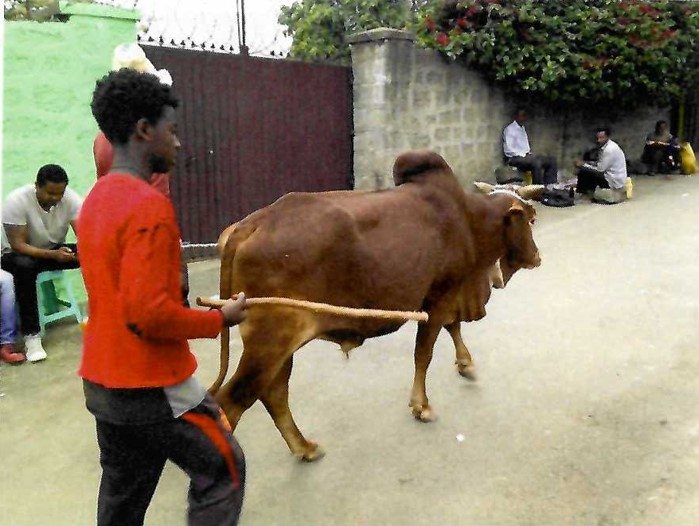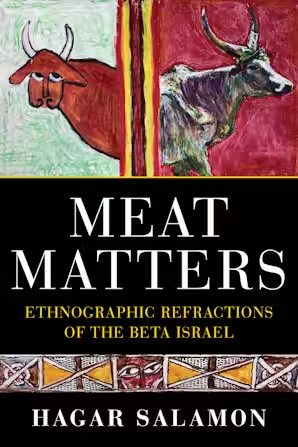Hagar Salamon
MEAT MATTERS: ETHNOGRAPHIC REFRACTIONS OF THE BETA ISRAEL
Indiana University Press, 2023. ISBN-13: 978-0253065780
Reviewed by Henry Schwarcz1
Starting in the 1970s, Jews began to emigrate from Ethiopia to Israel; today there are about 170,000 Βeta Israel or Falasha living in Israel. This book is an ethnographic study of some aspects of the lives of these people written by a professor of folklore, at the Hebrew University of Jerusalem. For almost thirty years Salamon has studied many aspects of the culture and ethnography of the Jews of Ethiopia. Her focus in this book is on consumption of meat, described both from the context of the lives of Βeta Israel living in simple huts in their homeland, and as they have been forced to adapt to life in apartment buildings in modern Israel. She has woven into this brief tale a general background to life in Ethiopia both for Jews and for the dominant Christian community.
For religious Jews consumption of meat has always presented problems, because of the necessity to slaughter animals according to the halachic rules that have been laid down by generations of rabbis, as well as restrictions on what animals, and what parts of those animals can be eaten. The Jews of Ethiopia, known as the Βeta Israel or Falasha, mainly have other concerns. The principal animal in their focus is the cow which, in Ethiopia, was a staple component of family existence, providing milk, pulling a plow, or otherwise contributing to daily lives. Then, on festive occasions, one cow would be slaughtered according to kosher practice. What happened afterwards was a complex and ethnologically unique experience in which the final result would be a series of identical piles of chunks of meat spread out on a cow skin (same cow!) on the ground. These would be distributed in a random fashion to the dozen or so male participants of the slaughter event. The stories related to these events and how they were (or were not) adapted to life in Israel is a large part of what Salamon spells out for us. Towards the end of the book, she describes in moving detail attending a slaughter event in the northern Negev, beginning with a view of the cow eating a last meal of grass, and ending with a table covered with almost identical piles of meat. These scenes and much else in the book are well-portrayed in text and excellent color photos by the author.

An ox being taken home from the market in Ethiopia, 2015
Judaism for the Beta Israel is derived from the five books of the Chumash, the bible of Moses, and does not include the complex web of practices and restrictions that were acquired from the writers of the Talmud and later rabbinic commentators. Consequently, certain aspects of food lore are absent from Beta meat practices. For example, the rule “Do not cook a young animal in its mother's milk” which appears three times in Chumash is interpreted by the Beta Israel to mean just that, and not to require the use of separate pots and cutlery. Oddly, however, the rule strictly barring consumption of blood does not appear to have struck the Beta Israel as of great importance during the butchering of animals (as far as one can tell from Salamon’s writing) and blood is widely spattered in the slaughter events. Salamon summarizes the complexities of life in Israel where the Beta Israel have had to accommodate to the strict kashrut imposed on them by the Israeli Rabbinate, and how they have tried to keep their own traditions alive in the face of these challenges. She interposes a few ‘funny stories’ encapsulating crises related to meat. For example, someone living in an apartment building accidentally gets off the elevator on the wrong floor, goes to someone else’s apartment, to their refrigerator and discovers a great pile of meat, precipitating a minor crisis which is peacefully resolved.
Most interesting to this reader, reading about the slaughter/distribution process, was a sense of equality amongst the participants in these events. This process is always carried out exclusively by adult men. In all societies, men tend to see themselves as socially stratified, in terms of wealth, birth ranking, skill, and so on. Yet, at the tables of ten or twenty meat piles everyone is counted equal, and care is taken to guarantee the anonymity of the piles. Presumably this establishes, to some limited extent, a notion of communality among the participants that extends out into their every-day lives. Unfortunately, it has not been generally possible to carry on this practice in Israel where one would hardly be permitted to keep a cow tied up in their parking lot, let alone invite a dozen friends to come to watch while a shochet-butcher converts the cow into dinners for everyone.
Hidden in the background of this book is the broader story of how and why the Jews of Ethiopia were gradually transposed to a new home in Israel. This is not relevant to the story of meat consumption, but it forms an important background to all aspects of Beta Israel life. Salamon occasionally refers to events in this transition but mainly leaves the reader to find out for themselves how this all took place.
The book is written by an academic ethnographer but is written for the most part in an easy-going, relaxed style which was a pleasure to follow. The life-problems of a few individuals crop up periodically to bring a closer sense of human experience. We learn that slavery was an important part of life of both Jews and others in Ethiopia and even until recently some large fraction of people were ‘barya,’ slaves. When they came to Israel, barya and their masters were united as one people and the distinction gradually disappeared…almost. Although the book is centered on meat production and distribution, we learn that most meals were based on vegetable foods (centered on chickpeas). Consuming a cow was an event of significance and, given the lack of refrigeration available, the meat was consumed within a few days of the slaughter. Now, living in homes with refrigerators and even freezers, meat consumption for Beta Israel people will have become less memorable in a social sense, and simply a part of a normal diet.
Even readers who are not ethnographers or academics of any kind would find this book a stimulating and well-balanced study of a fascinating social tradition that has had to be adapted to modern lifestyles. Regrettably, no recipes were included!
1 Henry Schwarcz is a Fellow of the Royal Society of Canada, D.Sc, Distinguished Professor emeritus, School of Earth, Environment and Society, McMaster University, Canada, author of more than 400 refereed papers and book chapters in geology, archaeology and studies of bone.

